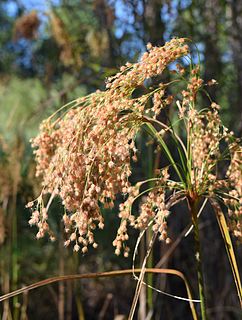
Scirpus is a genus of grass-like species in the sedge family Cyperaceae many with the common names club-rush, wood club-rush or bulrush. They mostly inhabit wetlands and damp locations.

Rubus strigosus, the American red raspberry or American raspberry, is a species of Rubus native to much of North America. It has often been treated as a variety or subspecies of the closely related Eurasian Rubus idaeus, but currently is more commonly treated as a distinct species. Many of the commercial raspberry cultivars grown for their fruit derive from hybrids between R. strigosus and R. idaeus; see Raspberry for more details.

Scirpus cyperinus, commonly known as woolgrass, is a herbaceous emergent that is native to the eastern United States and eastern Canada. Other common names include cottongrass bulrush and brown woolly sedge.
Scirpus diffusus is a species of flowering plant in the sedge family known by the common name umbrella bulrush. It is endemic to California, where it can be found in several of the high mountain ranges from the Klamath Mountains to the Sierra Nevada. It grows in wetland habitat and other moist areas, such as mountain meadows. It is similar to Scirpus congdonii and was described from herbarium specimens once mislabeled as such. It is a perennial herb forming a clump of erect stems growing up to a meter tall, solitary stems sometimes occurring as well. The stems are three-angled and narrow at the middle. Sheathing leaves occur at the stem bases as well as higher up the stems. The inflorescence occurs at the end of the stem, with small additional ones growing from the uppermost leaf axial. The inflorescence consists of several clusters of many spikelets wrapped at the bases in a leaflike bract.
Bolboschoenus robustus is a species of flowering plant in the sedge family. It is known by many common names: saltmarsh bulrush, alkali bulrush, sturdy bulrush, seacoast bulrush, stout bulrush, three-cornered sedge or leafy three-cornered sedge, and seaside club-rush.

Scirpus ancistrochaetus is a rare species of flowering plant in the sedge family known by the common names barbedbristle bulrush and northeastern bulrush. It is native to the northeastern United States from New Hampshire south to Virginia. It used to be found in Quebec but it is now thought to be extirpated there. It was also believed extirpated from the state of New York, but at least one population has been rediscovered in Steuben County in 2010. It is threatened by the loss and degradation of its wetland habitat. It is a federally listed endangered species.

Ageratina luciae-brauniae is a species of flowering plant in the aster family known by the common names Lucy Braun's snakeroot and rockhouse white snakeroot. It is native to the eastern United States, where it is limited to the Cumberland Plateau of Kentucky and Tennessee. It may also occur in South Carolina but these reports are unconfirmed.
Malaxis bayardii, or Bayard's adder's-mouth orchid, is a species of orchid native to northeastern North America. It is found from Massachusetts to North Carolina, with isolated populations in Ohio and Nova Scotia. There are historical reports of the plant formerly growing in Vermont and New Jersey, but it seems to have been extirpated in those two states It grows in dry, open woods and pine barrens at elevations of less than 600 m.

Bolboschoenus novae-angliae, common names New England bulrush, and Salt march bulrush is a plant species found along the Atlantic seacoast of the United States from Alabama to Maine. It grows in brackish and salt-water marshes and estuaries along the coast.

Lophiola is a genus of monocotyledonous flowering plants native to eastern North America. It has variously been placed in the Liliaceae, the Haemodoraceae, the Tecophilaeaceae or the Nartheciaceae.
Boltonia caroliniana, common name Carolina doll's-daisy, is a North American species of plants in the sunflower family. It is found only in the southeastern United States, primarily in the states of North Carolina, South Carolina, and Virginia with a few isolated populations in western Georgia.
Rubus aculifer, the thorny dewberry, is a rare North American species of flowering plant in the rose family.
Rubus adenocaulisis a rare North American species of flowering plant in the rose family. It has been found only in the Province of Nova Scotia in the eastern Canada.
Rubus tholiformis is a rare North American species of flowering plant in the rose family. It has been found only in eastern Canada and the northeastern United States.
Rubus adjacens, the peaty dewberry, is a rare North American species of flowering plant in the rose family. It is native to eastern Canada and the northeastern and east-central United States (Maine, New Hampshire, Vermont, Massachusetts, New York, Pennsylvania, Maryland.
Rubus defectionis, the Eclipse blackberry, is a rare North American species of flowering plant in the rose family. It grows in only a few locations in the east-central United States.
Rubus severus is an uncommon North American species of flowering plant in the rose family. It is found in eastern Canada and the northeastern and north-central United States.
Rubus kennedyanus is a rare North American species of brambles in the rose family. It is found in eastern Canada and in the north-central United States.
Rubus pernagaeus is a rare North American species of flowering plant in the rose family. It has been found only in the state of Virginia in the eastern United States.
Rubus longii is an uncommon North American species of brambles in the rose family. It grows in the eastern United States from Long Island to North Carolina.






